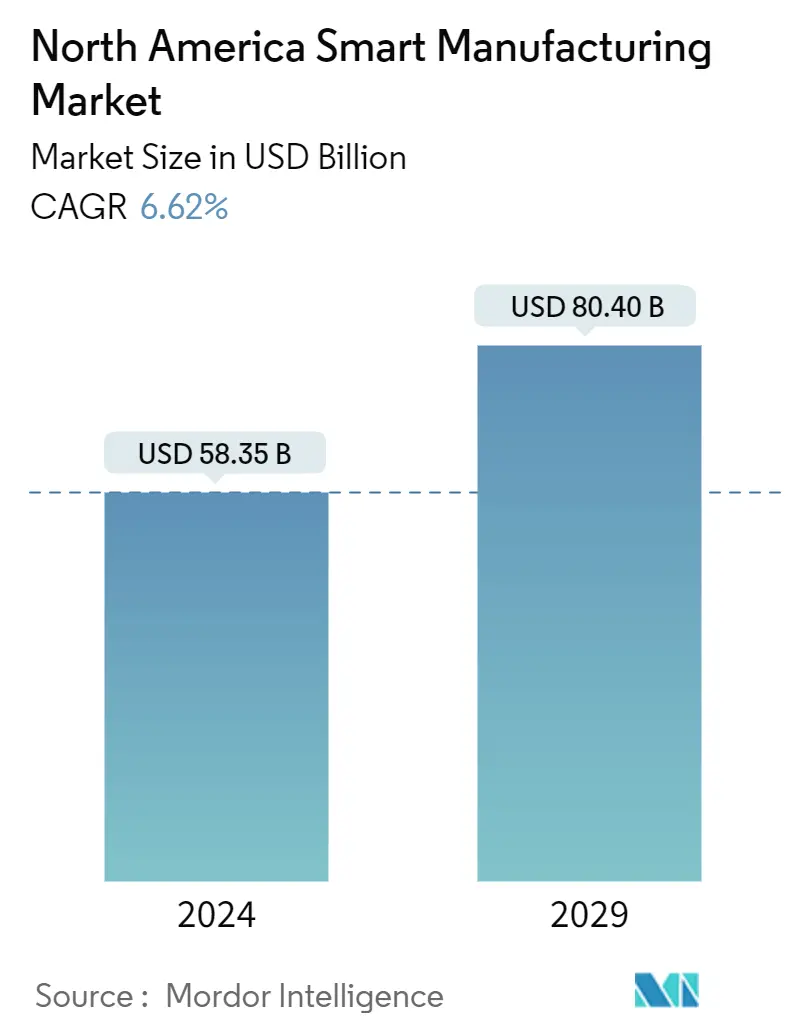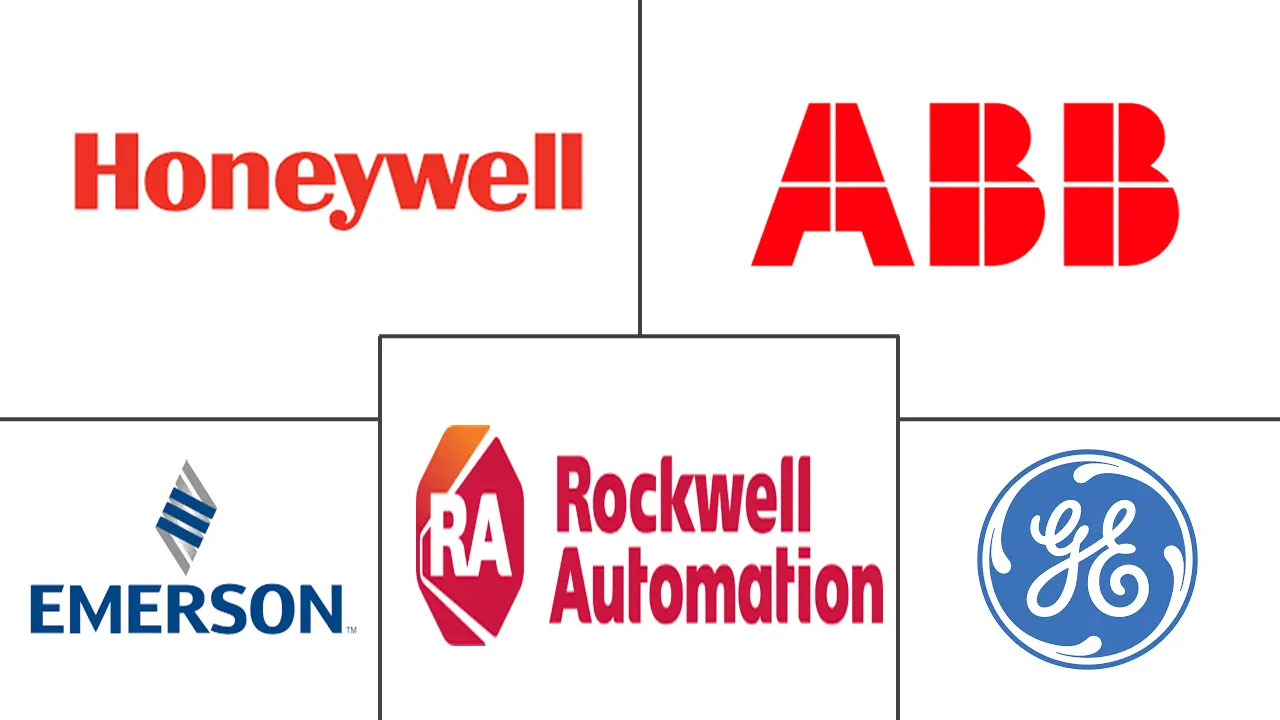Market Size of North America Smart Manufacturing Industry

| Study Period | 2019 - 2029 |
| Base Year For Estimation | 2023 |
| Market Size (2024) | USD 58.35 Billion |
| Market Size (2029) | USD 80.40 Billion |
| CAGR (2024 - 2029) | 6.62 % |
| Market Concentration | Medium |
Major Players
*Disclaimer: Major Players sorted in no particular order |
North America Smart Manufacturing Market Analysis
The North America Smart Manufacturing Market size is estimated at USD 58.35 billion in 2024, and is expected to reach USD 80.40 billion by 2029, growing at a CAGR of 6.62% during the forecast period (2024-2029).
The growing need for automation to attain efficiency and quality, the demand for adherence and government backing for digitization, and the proliferation of the IoT are some of the main driving factors influencing the market growth.
- North American manufacturers across every industry are creating the development foundation by rapidly improving their level of automation. While competing with global manufacturing hubs like Japan and China, North America has strived to create and adopt robotic and automation technologies. Therefore, to save energy and to gain cost-benefit, the trend of factory automation and industrial control systems is attaining traction in the region.
- The application of big data analytics in smart manufacturing aims to refine complicated processes, manage supply chains, and support new business models, like mass customization and product-as-a-service, which can be made possible by smart manufacturing apart from the traditional operational models like on-demand. Besides, big data analytics allows an enterprise to use smart manufacturing to shift from reactionary practices to predictive ones. This change targets improving the efficiency of the process and product performance, which in turn witnessed significant adoption in the region.
- However, The high costs of automated systems are concerned with effective and robust hardware and efficient software. Automation equipment requires high capital investment to invest in the smart factory (an automated system can cost millions of dollars to install, design, and fabricate). Also, the need for maintenance of automated machines is more than a manual system (even flexible automation is less flexible than humans, the most versatile machines of all). In addition to this, a series of significant cyber-attacks on manufacturing companies has highlighted the extreme and growing risks in the sector. The dependence on process control and systems, combined with the convergence of IT and operating technologies systems, has increasingly exposed manufacturing firms to cyber attacks.
- The regional automotive sector has always led the way in implementing robotics in its manufacturing processes. Other industry manufacturers, like John Deere, are also making significant investments to integrate automated technology into their products and processes. The regional manufacturing industry still needs to utilize these benefits fully. Hence, the region's automation adoption and product innovation scope is high.
North America Smart Manufacturing Industry Segmentation
Smart manufacturing uses computer-integrated manufacturing, high adaptability and quick design changes, digital information technology, and more adaptable technical workforce training, which includes fast changes in production levels based on demand, optimization of the supply chain, efficient production, and recyclability.
The scope of the market is limited to North America. The North American smart manufacturing market is segmented by technology, components, end-user industry, and geography (United States and Canada). The market sizes and forecasts are provided in terms of value (USD) for all the above segments.
| By Technology | |
| Programmable Logic Controller (PLC) | |
| Supervisory Controller and Data Acquisition (SCADA) | |
| Enterprise Resource and Planning (ERP) | |
| Distributed Control System (DCS) | |
| Human Machine Interface (HMI) | |
| Product Lifecycle Management (PLM) | |
| Manufacturing Execution System (MES) | |
| Other Technologies |
| By Component | |
| Communication Segment | |
| Control Device | |
| Machine Vision Systems | |
| Robotics | |
| Sensor | |
| Other Components |
| By End-User Industry | |
| Automotive | |
| Oil and Gas | |
| Chemical and Petrochemical | |
| Pharmaceutical | |
| Food and Beverage | |
| Metals and Mining | |
| Other End-User Industries |
| By Country | |
| United States | |
| Canada |
North America Smart Manufacturing Market Size Summary
The North American smart manufacturing market is poised for significant growth, driven by the increasing need for automation to enhance efficiency and quality. The region's manufacturers are rapidly advancing their automation levels to compete with global hubs like Japan and China, focusing on robotic and automation technologies to achieve energy savings and cost benefits. The integration of big data analytics is transforming traditional operational models, enabling predictive practices that improve process and product performance. However, the high capital investment required for automated systems and the need for robust cybersecurity measures pose challenges to widespread adoption. Despite these hurdles, the automotive sector leads in robotics adoption, with other industries like agriculture also investing in automated technologies.
The United States, a key player in the smart manufacturing landscape, is at the forefront of the fourth industrial revolution, leveraging data integration across supply chains. The automotive industry, a major revenue generator, continues to drive market growth, supported by initiatives like the Advanced Manufacturing Partnership. The oil and gas sector also contributes to demand for automation technologies. The market is semi-consolidated, with major players like Emerson, Rockwell Automation, and Honeywell focusing on expanding their global presence through strategic collaborations. Recent advancements, such as Emerson's NextGen Smart Firewall and Rockwell Automation's intelligent edge management platform, highlight the ongoing efforts to enhance cybersecurity and facilitate digital transformation in industrial settings.
North America Smart Manufacturing Market Size - Table of Contents
-
1. MARKET DYNAMICS
-
1.1 Market Overview
-
1.2 Industry Value Chain Analysis
-
1.3 Industry Attractiveness - Porter's Five Forces Analysis
-
1.3.1 Bargaining Power of Suppliers
-
1.3.2 Bargaining Power of Consumers
-
1.3.3 Threat of New Entrants
-
1.3.4 Threat of Substitute Products
-
1.3.5 Intensity of Competitive Rivalry
-
-
1.4 Assessment of COVID-19 impact on the industry
-
1.5 Market Drivers
-
1.5.1 Increasing Demand for Automation to Achieve Efficiency and Quality
-
1.5.2 Need for Compliance and Government Support for Digitization
-
1.5.3 Proliferation of Internet of Things
-
-
1.6 Market Restraints
-
1.6.1 Concerns Regarding Data Security
-
1.6.2 High Initial Installation Costs and Lack of Skilled Workforce Preventing Enterprises from Full-scale Adoption
-
-
-
2. MARKET SEGMENTATION
-
2.1 By Technology
-
2.1.1 Programmable Logic Controller (PLC)
-
2.1.2 Supervisory Controller and Data Acquisition (SCADA)
-
2.1.3 Enterprise Resource and Planning (ERP)
-
2.1.4 Distributed Control System (DCS)
-
2.1.5 Human Machine Interface (HMI)
-
2.1.6 Product Lifecycle Management (PLM)
-
2.1.7 Manufacturing Execution System (MES)
-
2.1.8 Other Technologies
-
-
2.2 By Component
-
2.2.1 Communication Segment
-
2.2.2 Control Device
-
2.2.3 Machine Vision Systems
-
2.2.4 Robotics
-
2.2.5 Sensor
-
2.2.6 Other Components
-
-
2.3 By End-User Industry
-
2.3.1 Automotive
-
2.3.2 Oil and Gas
-
2.3.3 Chemical and Petrochemical
-
2.3.4 Pharmaceutical
-
2.3.5 Food and Beverage
-
2.3.6 Metals and Mining
-
2.3.7 Other End-User Industries
-
-
2.4 By Country
-
2.4.1 United States
-
2.4.2 Canada
-
-
North America Smart Manufacturing Market Size FAQs
How big is the North America Smart Manufacturing Market?
The North America Smart Manufacturing Market size is expected to reach USD 58.35 billion in 2024 and grow at a CAGR of 6.62% to reach USD 80.40 billion by 2029.
What is the current North America Smart Manufacturing Market size?
In 2024, the North America Smart Manufacturing Market size is expected to reach USD 58.35 billion.

